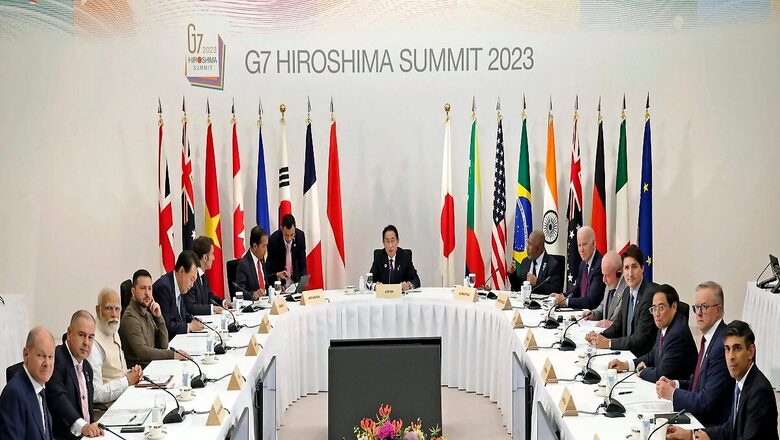
views
The group of seven nations — known as the G7 — was founded in 1973. It comprises four victors of the Second World War and three of the vanquished.
The United States, France, Canada and Britain co-opted defeated Germany, Italy and Japan on the principle of keeping friends close, enemies closer. The G7’s mission was to establish a rules-based world order. The rules were set by the G7 which in the 1970s accounted for over 80 per cent of the world’s economy.
There were two notable absentees in the G7 — China and the Soviet Union. China’s GDP in 1975 was a puny $0.16 trillion. In contrast, US GDP in 1975, at $1.68 trillion, was ten times larger. Today China’s GDP is $18 trillion, larger than the combined GDP of six of the G7 nations — Japan, Germany, Italy, Britain, France and Canada.
In 1997, the G7 co-opted Russia, following the dissolution of the Soviet Union, into a new G8. The hope was that Russia, as part of the G8, would cease being a threat to the G7-led world order and fully Europeanise itself.
Russia was at the time lurching from one economic disaster to another under President Boris Yeltsin’s chaotic leadership in 1991-99. At its weakest, economically and militarily, the G7 believed co-opting Russia could end for good all credible opposition to the West.
China was still a small economy. Its GDP at $0.96 trillion in 1997, when Russia joined the new G8, was a fraction of America’s $8.6 trillion. China’s military was rudimentary. The People’s Liberation Army (PLA) had fought a short, unsuccessful war with Vietnam in 1979 which ended in a stalemate.
With no economic or military threat on the horizon, the G7 did much as it pleased through the 1990s: the Gulf war; a ten-year-long no-fly zone over Iraq that led to thousands of deaths among Iraqi children starved of food and medicines; the dismemberment of Yugoslavia and other east European states; and unfettered weapons sales to non-NATO ally Pakistan.
When Vladimir Putin assumed Russia’s presidency in 2000, he wanted to make the relatively new Russian Federation a prosperous part of Europe after Yeltsin’s disorderly decade. Moscow had reluctantly accepted the dissolution of the Soviet Union in 1991 as history. Part of the Soviet Union’s nuclear arsenal had been positioned in its largest satellite state, Ukraine. In 1994, Ukraine voluntarily surrendered all Soviet nuclear weapons to Russia.
But by 2007, Putin realised that the G8 had no intention of keeping its key promise: stopping former Soviet satellite states from joining NATO and bringing the US-led military alliance to Russia’s doorstep.
At the Munich Security Conference in 2007, Putin warned the assembled global political and military leaders: “It is obvious that NATO expansion does not have any relation with the modernisation of the Alliance itself or with ensuring security in Europe. On the contrary, it represents a serious provocation that reduces the level of mutual trust. And we have the right to ask: against whom is this expansion intended? And what happened to the assurances our Western partners made after the dissolution of the Warsaw Pact? Where are those declarations today? No one even remembers them. But I will allow myself to remind this audience what was said. I would like to quote the speech of NATO General Secretary Mr. Woerner in Brussels on 17 May 1990. He said at the time that: ‘The fact that we are ready not to place a NATO army outside of German territory gives the Soviet Union a firm security guarantee.’ Where are these guarantees?”
In 2014, seven years after Putin’s Munich speech, the grounds for the Russia-Ukraine war were laid. The Russian-speaking Donbas region in Ukraine witnessed armed conflict between Russian separatists and Ukrainian nationalists. The Minsk I and Minsk II agreements in 2014 and 2015 failed to end the fighting.
The two Minsk agreements called for constitutional reform in Ukraine, including giving self-government to parts of the Donbas region which lies at the heart of the current Russia-Ukraine war.
With the Minsk agreements in tatters, Putin pre-emptively annexed Crimea in 2014. The US-led West responded by expelling Russia from the G8 which reverted to the G7 in 2014.
But by now a new threat to the G7 world order had emerged: China.
Between 2006 and 2014, China’s GDP had leapfrogged from $2.75 trillion to $10.48 trillion. Blindsided by its fixation on weakening Russia, the G7 had taken its eye off Beijing.
The G7 today reflects an old world order that has been overtaken by a shift in the balance of global power from the North Atlantic to the Indo-Pacific.
During his four-day state visit to the US beginning June 22, Prime Minister Narendra Modi will sign a raft of agreements with President Joe Biden. One of the most important agreements is the production in India of GE engines for India’s new generation of fighter jets along with the transfer of advanced engine technology to India.
Washington rarely shares critical defence technology with even NATO allies so the GE deal could set a precedent. It marks a historic shift in the India-US relationship. Washington has belatedly woken up to the unfolding geopolitics of the second quarter of the 21st century. By 2026, the US and Indian economies will have a combined GDP of over $30 trillion. That will be larger not only than China’s estimated 2026 GDP of $22 trillion but nearly double the combined GDP of six of the G7 nations — Germany, Japan, Britain, France, Italy and Canada.
The G7-led world order has passed its expiry date. That fact will be etched firmly on the minds of Biden and Modi when they break bread in Washington this month.
The writer is an editor, author and publisher. Views expressed are personal.












Comments
0 comment